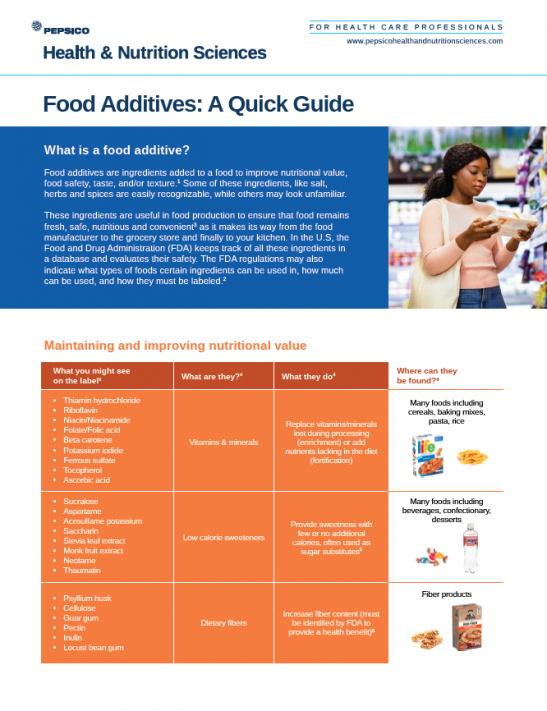Food Additives: A Quick Guide
Description: Learn about common additives in food and beverage processing, their use and their safety.
- Definition of a food additive
- Types of food additives and their benefits and function
Food additives are ingredients added to a food to improve nutritional value, food safety, taste, and/or texture.1 Some of these ingredients, like salt, herbs and spices are easily recognizable, while others may look unfamiliar.
These ingredients are useful in food production to ensure that food remains fresh, safe, nutritious and convenient 3 as it makes its way from the food manufacturer to the grocery store and finally to your kitchen. In the U.S, the Food and Drug Administration (FDA) keeps track of all these ingredients in a database and evaluates their safety. The FDA regulations may also indicate what types of foods certain ingredients can be used in, how much can be used, and how they must be labeled. 2
The main purpose of food additives is to maintain and/or improve the 4
- Nutritional value of foods
- Safety and freshness of foods
- Taste, texture or appearance of foods
How do food additives help to maintain and improve the nutritional value of our foods?
- Vitamins and minerals, such as Thiamin hydrochloride, Riboflavin, Niacin/Niacinamide, or Folate/Folic acid, replace the vitamins and minerals lost during processing (enrichment) or add nutrients lacking in the diet (fortification). Vitamins and minerals are added back into many foods like cereals, baking mixes, pasta and rice.
- Low-calorie sweeteners, such as sucralose, aspartame, acesulfame potassium, or saccharin, provide sweetness with few or no additional calories and often used as sugar substitutes 5 . These additives can be found in beverages, confectionary, and desserts.
- Dietary fibers, such as psyllium husk, cellulose, guar gum or pectin, increase the fiber content (must be identified by FDA to provide a health benefit) 6 . These food additives are found in fiber products.
What is the purpose of food additives in maintaining and improving the safety and freshness of our foods?
- Preservatives, such as sodium benzoate, sodium nitrate, and sorbic acid, extend storage and shelf-life by stopping or slowing the growth of fungi, bacteria, or microorganisms. These are often found in cured meats and in beverages.
- Other types of preservatives, like BHA, BHT, and ascorbic acid, prevent changes in color, flavor, and texture and delay the production of undesirable odors. These are added to cereals, baked goods, and beverages.
What types of food additives improve taste, texture, or appearance of our foods?
- Leavening agents, such as sodium bicarbonate or calcium carbonate, promote rising in baked goods. These are used in pancakes and baking mixes.
- Anti-caking agents, such as silicon dioxide and aluminum silicate, prevent clumping, especially in foods found in powder or granule form like drink mixes.
- Emulsifiers, such as gelatin, lecithin, or mono- or diglycerides, stabilize mixtures of oil and water to prevent separation. These are used in products like protein shakes, sauces, and chocolate.
- Stabilizers, thickeners, binders, and texturizers, such as agar, pectin, gum Arabic or whey, provide uniform texture and improved mouth feel to foods like pudding mixes, sauces, and frozen desserts.
Click the link to the right to download the handout to use with your patients and clients!
